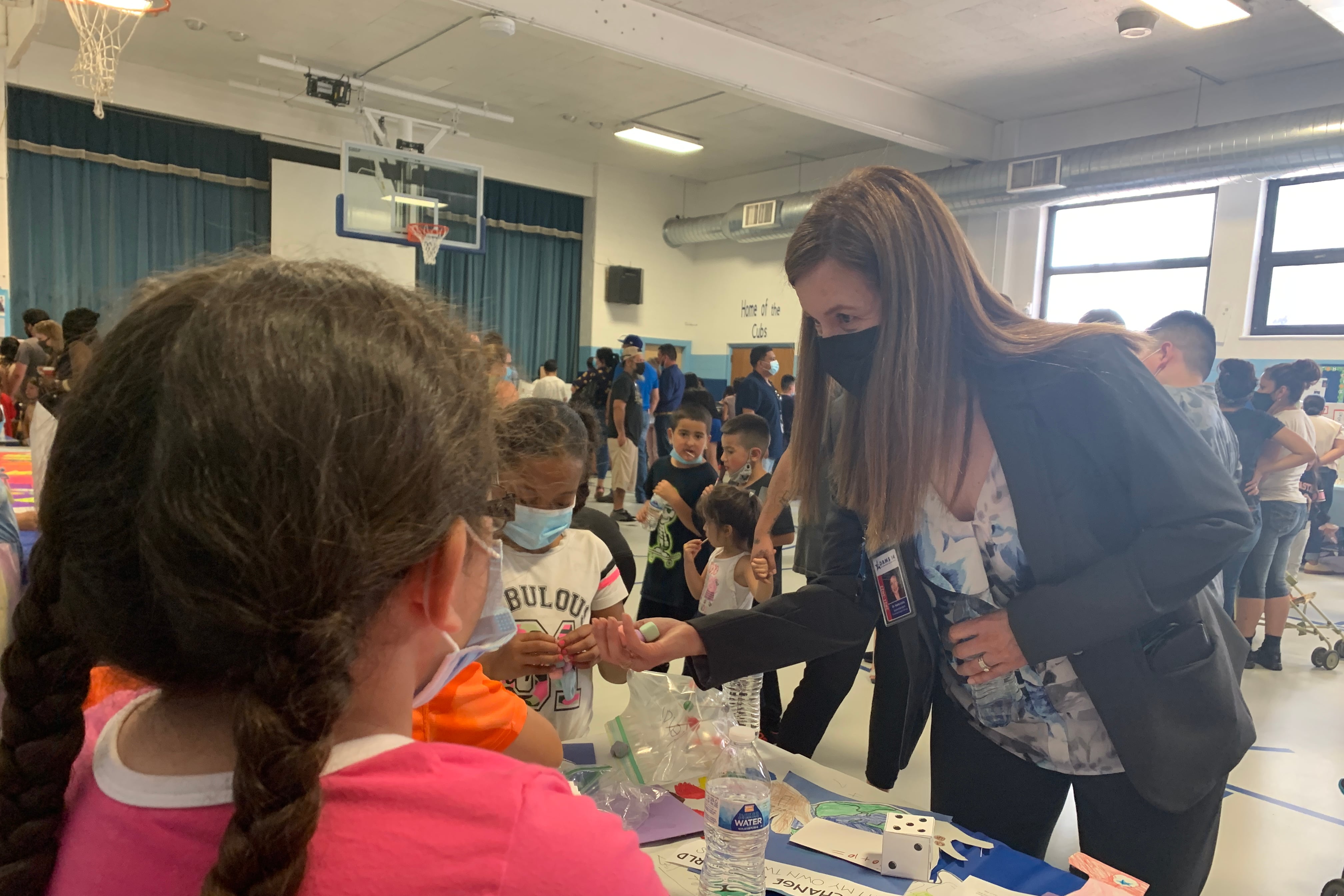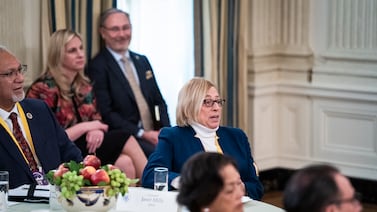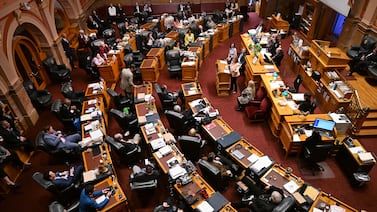Two weeks into her new role, Adams 14 Superintendent Karla Loria met with principals Wednesday — marking the end of their summer breaks and the beginning of fall prep.
Loria, a new grandmother, spent the better part of her 32 years in education on turnaround work. She said she’s ready to step into the superintendent role in the small suburban Denver district on a state-mandated improvement plan.
Adams 14 is the first Colorado district where the state has ordered an outside group to help manage changes. The district is entering the third year of a four-year, state-ordered plan. The goal: better student outcomes after several years of low performance.
Now, for the first time in a couple of years, the district has its own superintendent as the management company, MGT Consulting, will start stepping back. Exactly what the shared management roles will look like in the final two years of the improvement plan remains unclear. But mapping out those roles is among the work Loria is jumping into, along with hiring lots of new staff. Loria, who until recently was the chief academic officer for Clark County School District in Nevada, spoke with Chalkbeat about how she is approaching her new role.
This interview has been lightly edited for length and clarity.
What was it about leading Adams 14 that appealed to you?
First of all, on a personal level, an interest in returning to Colorado. Our girls are here. Having a new grandchild, it was very appealing to me just to return to Colorado. After the pandemic and going through some serious health issues my husband had … you think about what is important a little differently. On a professional level, when I started looking at what were the options and where to start looking, several colleagues talked to me about Adams 14. I did research and what really appealed to me was the great challenge and opportunity to do turnaround work. That’s where I feel I actually thrive, where I feel I can service communities. I know I have been through experiences in different districts with different leaders and mentors leading change for improvement, so it just appealed to me. I am a believer. I prayed a lot about it, and I decided to apply.
What have you been doing in your first couple of weeks on the job?
In June, once I was approved by the board, I started having one-on-one meetings. Of course, I had my other job as well, so I was taking vacations days, half days, or meeting individuals at night. Being in a turnaround situation, knowing there’s a manager group also involved, I felt a great need to dive in as deep as I could at first.
In my first two weeks, I met with more than 20 individuals one-on-one — individuals from central office, from schools, community members, meeting with colleagues, as well, administrators from surrounding districts to understand it all better. Of course, I went around the schools. The team has been very busy interviewing for some vacancies that we have. We have three principal vacancies and some in central office. I believe in hiring hard and managing easy. I believe in really looking for the right person, and that may take a little longer. We’ve been working hard hiring at least eight administrative positions these two weeks, and we met [recently] with principals for the first time. I spent all morning with the team, welcoming them and setting the tone. We started looking at the data and framing how we’re going to structure ourselves to support our students and our teachers.
What do you look for when hiring and building a team to do turnaround work?
It goes in layers, I believe. I am a national trainer for the Haberman foundation. (The foundation is based on research from Martin Haberman, focusing on how to select teachers and administrators that are most likely to be effective in high-poverty schools). Having been trained in that and actually becoming a trainer later in my career, I first and foremost look for a belief system — that internal belief system that, at the end of the day, will guide our behaviors and will set the tone for what we believe. So I look for individuals who are coachable, who will have students as the No. 1 priority with no excuses. We adults sometimes find excuses left and right. Things happen, but what we can control, there should not be any excuses. I look for those individuals with the grit to collaborate and to really find what is it that students need. Sometimes it’s difficult to find the individuals that will do turnaround or have that grit. It’s hard work.
Of course, that instructional focus will be the second layer. Understanding instruction and understanding that our role as leaders is to develop our teachers, to support our teachers so they can support our students. We cannot fire ourselves to greatness; we need to develop our teams to greatness.
What are your plans for the district? What do you hope to accomplish?
Short-term, of course, is to be able to staff everything. We have just a couple of weeks to make sure that we got everything structured. That is the immediate goal to make sure we are fully staffed not only at the central office level but also making sure that our schools are fully staffed.
Shorter-term, maybe 90 days, is really to meet with different individuals to better understand the district at a deeper level. To better understand maybe some of the circumstances that made us get where we are right now. I may not have created that, but I own it, so I need to truly understand it so that we can start turning things around quickly. Within my first 100 days, I’m trying to really let people get to know me, see how we structure our teams, really understand the skill set, and make sure everyone is at the right seat of the bus. Longer-term, of course, [the goal is] to make it right for children. Our students have only one year in this one grade level. So when I think about turnaround, I don’t say, oh, we have three to five years — or two years in our case with our state order. I think we’ve got this year to make it right for this one set of kids.
Longer-term, my vision and my goal for the district is really to be on the map for a very different reason. I look at Adams 14 as being in a place where we can put the district on the map for being an advanced district, maybe bringing a STEM program for every school, or being bilingual, supporting the two languages.
As a child, my first language was Spanish, and my father always told us being bilingual is leaving school with a career because it will open doors in ways that we didn’t think doors existed, and that has been my experience. I want that for our children. I want to make sure that every single one of our students and our families and our community sees that being bilingual, speaking another language is a plus that will bring a richness to our communities.
About half of Adams 14 students are English learners, mostly native Spanish speakers like yourself. What do you think you can do to support this group of students and help them succeed?
What will make the most difference is to recognize it’s a plus to be bilingual and to bring in support to actually help them become biliterate. Bringing an understanding and helping the administrators and the teachers understand bilingual programs, dual-language programs, and the differences between them. And also to provide resources that will support both cultures, so that is one thing. Also, I believe something that will support the students is bringing in individuals and adults that will reflect the makeup of our student population. They need to see role models in all of the schools. I believe that’s something we need to pay close attention to.
You’ve done a lot of turnaround work before. From what you’ve seen so far, do you believe it’s possible for Adams 14 to improve its state ratings in two years? If so, what do you think is most crucial to that improvement?
Absolutely, I do believe it’s possible. Otherwise, I wouldn’t be here. I’ve seen it before; I’ve experienced it before. It’s not a one-man show kind of work. It’s really all of us getting together, collaborating, and understanding what we need to do. All the time, we work hard, but sometimes we don’t work smart, so we just need to shift our focus from working hard to working very smart with a laser-like focus. What I have seen works is looking at the individual child, knowing the stories of the kids, and understanding how we can support the very individual needs of students. And monitoring. It’s really going into classrooms, often working with teachers to help them plan and develop their skillset as far as differentiation.
Tell me about what experience you’ve had with parents in the district. For those that don’t trust the district, how do you hope to push past that?
I was able to visit with many of the parents. Just engaging with them and having conversations about what their perceptions are. I realized that sometimes central offices think we’re providing this kind of support, but it’s perceived so differently. I really want to learn and understand their perception as far as the support we offer to them as families and their students. So I have been engaging with them, and one thing has been constant: It’s how much they appreciate our schools — how much they want to be in our schools, and also how much they want our schools to do better. One thing I am 100% sure of is how much our parents value and appreciate our teachers.
Read more: Parents urge Adams 14 and its external manager to engage the community more
What I would like from our parents is more of that input, not only for us to listen but to co-plan and collaborate. I believe that going a step further will be: What evidence can we offer or should there be to ensure parents we are working on it? And how do we organize ourselves, so there are frequent opportunities to come and say, this is what we see, and this is what we do not see? It’s so difficult to regain trust. We need to be consistent and not just bringing parents in, but going out to see what they want and going beyond that. How will you know we are incorporating the feedback? Sometimes it makes sense, and sometimes it won’t, but then it’s telling them that. So I think it’s just being transparent about when we can and cannot [do certain things]. When we say we will let’s do it, let’s set up benchmarks; and when we fail, we need to say we failed. There may be a reason, but there cannot be excuses.







